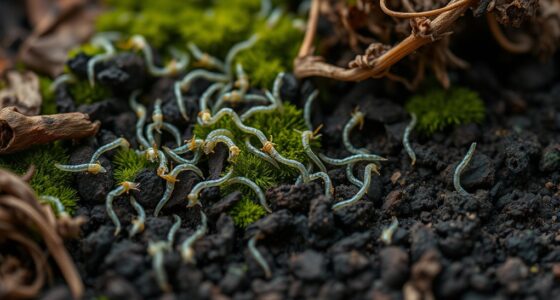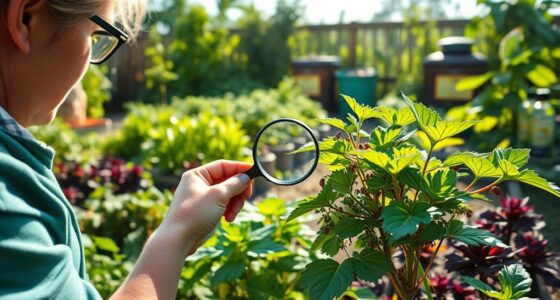Meet your garden’s natural bodyguards: beneficial nematodes. These microscopic predators hunt and control soil pests like grubs, beetle larvae, and root maggots without chemicals. When applied properly, they quickly infect and kill pests underground, promoting healthier plants and soil. To maximize their effectiveness, apply nematodes during warm soil conditions and keep the soil moist. Keep exploring to discover how to use these beneficial allies for a thriving, pest-free garden.
Key Takeaways
- Beneficial nematodes naturally target soil pests like grubs and beetle larvae, promoting healthier plants without chemicals.
- Apply nematodes during soil temperatures of 55°F–80°F, preferably early morning or late afternoon.
- Mix nematodes with water per manufacturer instructions and apply promptly for maximum effectiveness.
- Keep soil moist and avoid disturbing the soil immediately after application to support nematode activity.
- Reapply every few weeks during pest season to maintain effective pest control and enhance garden health.

Have you ever considered how natural predators can help control garden pests? Beneficial nematodes are just that—powerful, microscopic allies that target a variety of soil-dwelling pests without the need for chemicals. When it comes to pest control strategies, integrating nematodes into your garden routine can be one of the most effective and eco-friendly methods. These tiny worms actively seek out pests like grubs, beetle larvae, and root maggots, injecting them with bacteria that quickly kill their hosts. This biological approach not only reduces the reliance on chemical pesticides but also promotes healthier soil and plants.
Natural predators like beneficial nematodes effectively control soil pests without chemicals.
To get the most out of beneficial nematodes, understanding nematode application tips is essential. First, timing is everything. Apply nematodes when soil temperatures are between 55°F and 80°F, typically in early morning or late afternoon to avoid direct sunlight, which can harm them. Moisture is equally important; nematodes need a damp environment to move freely and infect pests. Water your garden thoroughly before and after application to keep the soil consistently moist. Use a gentle spray or watering can to distribute the nematodes evenly over the affected areas, ensuring they reach the pest hotspots underground.
Another key tip is to prepare the application solution correctly. Most nematodes come in a packet or a liquid concentrate that requires dilution in water. Follow the manufacturer’s instructions carefully—using too little or too much can reduce their effectiveness. Once diluted, apply the solution promptly, as nematodes are sensitive to temperature and light. It’s best to use them within a few hours of mixing to guarantee maximum vitality.
Incorporating nematodes into your pest control strategies means making them a regular part of your garden maintenance. Reapply every few weeks during the pest season, especially after heavy rains or irrigation that might wash them away. Keep the soil moist and avoid tilling or disturbing the soil immediately after application, as this can damage the nematodes and reduce their efficacy. With patience and proper application, beneficial nematodes can notably decrease pest populations, leading to healthier plants and a more balanced garden ecosystem.
In essence, using beneficial nematodes is an intelligent, sustainable pest control strategy that harnesses nature’s own defenses. By following simple nematode application tips and timing your treatments correctly, you turn your garden into a battlefield where pests are naturally kept in check, all without harmful chemicals. This approach not only protects your plants but also supports the overall health of your garden’s soil and environment.
Frequently Asked Questions
Are Beneficial Nematodes Safe for Pets and Children?
You’re wondering if beneficial nematodes are safe for pets and children. Rest assured, they are generally considered safe, offering excellent pet safety and child protection. These microscopic organisms target pests without harming humans or animals. When used properly, beneficial nematodes won’t pose risks to your loved ones. Always follow application instructions to guarantee safe use, and consult local guidelines if you have specific concerns about pet safety or child protection.
How Long Do Beneficial Nematodes Last in the Soil?
Many believe beneficial nematodes last indefinitely in soil, but environmental factors actually influence their longevity. Typically, they remain effective for about 2-4 weeks after application. Soil conditions like moisture, temperature, and microbial activity impact their survival, so they may break down sooner in harsh environments. To maintain pest control, reapply nematodes regularly, especially during ideal weather, ensuring they stay active and effective in your garden.
Can Beneficial Nematodes Be Used Indoors?
Yes, you can use beneficial nematodes for indoor pest control. Nematode application is effective against soil-dwelling pests like fungus gnats and thrips larvae. Just confirm the environment is moist and the temperature is suitable, typically between 55-85°F. You’ll want to apply nematodes directly to the soil, making sure they reach the pests. This natural method is safe for indoor spaces and provides an eco-friendly way to protect your plants.
Do Beneficial Nematodes Target Specific Pests Only?
Think of beneficial nematodes as stealthy warriors—they aim precisely where pests lurk. Pest specificity varies among nematode targeting, with some species targeting only particular pests while others have a broader reach. You can trust that these natural allies focus on their intended targets, minimizing harm to beneficial insects and your plants. So yes, many beneficial nematodes target specific pests, making them an effective, eco-friendly pest control option.
What Environmental Conditions Do Beneficial Nematodes Require to Thrive?
Beneficial nematodes thrive best when soil moisture is adequate, as they need a moist environment to move and infect pests. They also require specific temperature ranges, typically between 55°F and 85°F, to remain active and effective. If the soil is too dry or too hot or cold, their activity decreases. To guarantee success, keep the soil consistently moist and apply nematodes during ideal temperature conditions.
Conclusion
Think of beneficial nematodes as your garden’s secret army, silently patrolling underground like tiny knights in shining armor. They hunt down pests lurking beneath the soil, turning your garden into a peaceful fortress. With these microscopic guardians on your side, you’ll watch your plants flourish like a lush, vibrant oasis. Embrace these natural defenders, and let your garden thrive in harmony, protected by nature’s tiny, tireless warriors working tirelessly beneath the surface.









